Drones: they’re advanced, intelligent, and applicable to many different industries. One industry they’ve had a particular effect on, though, is agriculture.
Thanks to robust new investments on the part of manufacturers, and changing drone regulations, drones have made a significant splash in the world of agriculture, overhauling the industry and changing things in marked, positive ways.
Here’s what you need to know about drone farming and agriculture.
4 Benefits of Agriculture Drones
While drones have been used in the private sector for decades, they’re just now becoming popular in the world of agriculture.
According to a percent PwC analysis, the total addressable value of drone-powered solutions in all applicable industries is significant—more than $127 billion.
One of the most promising industries for drones is agriculture. Drones are busy addressing significant challenges and streamlining many parts of the industry. By 2050, experts estimate that the world’s population will reach 9.7 billion. As the population continues to grow, agricultural consumption will rise by a projected 70%.
Here’s how drones are helping:
1. Increased Productivity and Reduced Costs
One of the biggest benefits of drones is the fact that they can boost the productivity of the agriculture sector. As the world’s population continues to grow, the demands on agricultural production will increase, as well.
Drones suit the needs of the growing farming industry. For example, they offer more advanced forms of corp monitoring, faster inspections, precision, and advanced measuring tactics that help farmers conserve water and chemicals.
While imaging crops with a man-operated aircrafts can cost $1,000 an hour or more, drones can be purchased for less than $1,000. Taken together, these functions help companies increase productivity and put more food on the table for American families.
2. Accuracy & Efficiency
Farms are big places. Human inspectors are a bit limited in what they can produce on any given day. Walking fields, or even viewing them from a helicopter, is only so accurate. To make matters worse, it’s also expensive and time-consuming.
Fortunately, drones provide another option. Because drones are light, silent, and easy to deploy, they boost the accuracy and efficiency of any given farming operation. When equipped with advanced thermal and geographic sensors and mapping equipment, they can also deliver information human inspectors simply cannot.
3. Reducing Pollution
Each year, our country’s waterways are polluted by runoff from industrial pesticides and fertilizer.
According to the Environmental Protection Agency’s (EPA) Protecting Water Quality From Agricultural Runoff publication, “In the 2000 National Water Quality Inventory, states reported that agricultural nonpoint source (NPS) pollution is the leading source of water quality impacts on surveyed rivers and lakes, the second-largest source of impairments to wetlands, and a significant contributor to contamination of surveyed estuaries and groundwater. “
Don’t worry, though. The publication goes on to state, “Farmers and ranchers can reduce erosion and sedimentation by 20 to 90 percent by applying management practices that control the volume and flow rate of runoff water, keep the soil in place, and reduce soil transport.” When it comes to well-timed and well-measured application of pesticides, agriculture drone spraying is here to help. By allowing farmers to gauge precisely how much pesticide they should apply and when drones cut down on agricultural pollution and help make the environment a safer place.
4. Boost Yields
According to the Association for Unmanned Vehicle Systems International, farms will eventually account for an 80% share of the commercial drone market. And for a good reason.
Drones help boost yields and increase profits. According to the American Farm Bureau Federation, farmers using agriculture drones could see an ROI of $12 per acre for corn and $2 to $3 per acre for soybeans and wheat.
6 Use Cases: What Drones Do for Agriculture
As you can tell from the benefits section above, drones have many different uses in agriculture. These uses include the following:
- Crop Monitoring. Drones provide unmanned, aerial crop monitoring that is more efficient and less expensive than traditional monitoring techniques.
- Crop Spraying. Drones offer precise spray measurements and help farmers cut down on their use of both chemicals and water.
- Soil & Field Analysis. Drones can take advanced soil and field samples, zooming in to count and evaluate individual plants and identify areas of concern.
- Harvest Planning. Thanks to advanced mapping and GPS technologies, drones can help farmers plan upcoming harvests and identify the most promising areas.
- Insurance. Insurance is a significant consideration for the agriculture industry. Fortunately, drones can help farmers stay in compliance and keep their farmers insured.
- Health Assessment. If a virus wipes out a field, farmers lose thousands. Fortunately, drones can conduct individual health assessments of plants, and collective assessments of fields as a whole.
Drone Nerds Recommended Drones
Looking for the best UAV agriculture drone to use in your applications? Here are our top recommendations.
- Agras MG1P. This crop-spraying drone is one of our most purchased. The 8-rotor Agras MG-1S and MG-1P aircraft promote smart agriculture by surveying fields quickly, accessing online analysis, and distributing chemicals at calculated rates, all done safely with the operator on the ground.
- Aerovironment Quantix. Quantix™ was developed for on-farm reliability and features a durable, lightweight airframe with a one-meter wingspan and carbon fiber spar reinforcement. Vertical takeoff and landing provide for the safest flight operations while protecting valuable on-board cameras.
- Inspire 1. They lift creativity and on-the-job performance to new heights with versatility and competencies. The Inspire 1 and Inspire 2 play roles on many stages: Properly equipped, they safely conduct industrial inspections of hard-to-access assets; sense and record heat loss in buildings; do police surveillance, even at night; find disaster victims in search-and-rescue operations, and gather agricultural data for analysis in smart farm management. The compatible sensors for the Inspire 1 are Micasense sensors.
- M600. DJI Matrice enterprise drones are high-tech industrial workhorses with extended flight time, IP43 foul-weather capability, camera flexibility, and adaptability to SDK development. They serve a broad range of engineering, industrial inspection, and broadcasting/filmmaking functions. The compatible sensors for the M600 are Slantrage, Micasense, and Sequoia+.
- Parrot Bluegrass Fields. The Parrot line of solutions provides a comprehensive approach to crop analysis. A standard camera and multispectral sensor can be combined for post-processing in Parrot Fields to capture real-time details so farmers and agronomists can make real-time decisions and increase their yields.
- The M200 & M210. What makes these drones so powerful is their sensors. The sensors in each drone work together to create a full surveying solution for the agriculture industry. The compatible sensors for M200 & M210 are Slantrage, Sequoia +, Micasense and Sentera.
No matter what you’re looking for in a drone, DroneNerds is here to help. Contact us today for pricing, guidance, and more.




